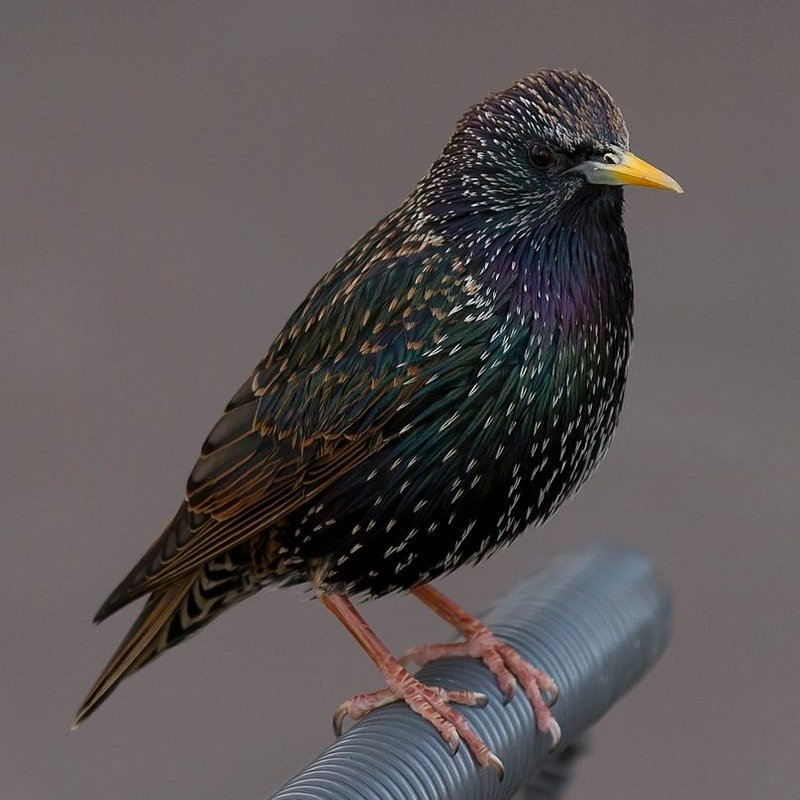European Starlings were first introduced to North America in the nineteenth century by Shakespeare enthusiasts, and they are now one of the continent’s most numerous songbirds, numbering in the millions. Known as the common starling or European starlings, in Latin named as Sturnus vulgaris, is a medium-sized passerine bird belonging to the Sturnidae family of passerine birds. In large, raucous flocks, they wheel through the sky and mob lawns for much of the calendar year.
Quick Overview: Sturnus Vulgaris – European Starling Body size: Around 8.5 inches (22 cm) in length with 85 g (3 oz) in weight
Main colors: Purple, Green, Yellow, Pink, Black
Range: Throughout the United States
Migratory Bird: Yes
Best time of the year to see in the U.S.: All Year (January – December)
Conservation Status: Least Concern
European starling Description
European Starlings is a chunky purple and green blackbird with a long yellow bill and pink legs. Back and under tail feathers are buffly trimmed. Feeds in open areas on the ground. Strong, direct, and rapid flight on beating wings.

Size
It is 8.5 inches (22 cm) in length with 85 g (3 oz) in weight and 10.5- 15.5 in (35 cm). 39 cm (15.5 in).
Feeding
Seeds, insects, small vertebrates, centipedes, spiders, earthworms, plants, and fruits are among the foods that this species consumes; it frequently consumes food that has been discarded by humans.
Habitat
Common starlings prefer coastal areas, where they nest and roost on cliffs, and forage among the seaweed. Their adaptability to a wide range of habitats has allowed them to spread and establish themselves globally, from coastal wetlands to alpine forests, sea cliffs to mountain range 1,900 m (6,200 ft) above sea level.
Behavior
The common starling is a social bird, especially in the winter. Large, noisy flocks (murmurations) can form near roosts. These dense flocks of birds are thought to deter predators like peregrine falcons and Eurasian sparrowhawks. In-flight, flocks form a tight sphere-like formation, expanding and contracting and changing shape without a leader. The movement of its closest neighbors affects the course and speed of each common starling.
Sturnus Vulgaris Scientific Classification
- Kingdom: Animalia
- Phylum: Arthropoda
- Subphylum: Chelicerata
- Class: Aves
- Order: Passeriformes
- Family: Sturnidae
- Genus: Sturnus
- Species: Sturnus vulgaris
Best time of the year to see
In the United States, the best time of year to see these birds is all year round, regardless of the season. This refers to any month of the year between January and December.
Distribution of the Sturnus vulgaris in the USA
Originating in Eurasia, but now established globally. Occurs from southern Alaska to Newfoundland, and from there to the Gulf Coast and northern Mexico. These species of birds are now throughout the continental United States as well.
The Sturnus vulgaris can be found in the following states in the United States – Alabama, Arizona, Arkansas, California, Colorado, Connecticut, Delaware, Florida, Georgia, Hawaii, Idaho, Illinois, Indiana, Iowa, Kansas, Kentucky, Louisiana, Maine, Maryland, Massachusetts, Michigan, Minnesota, Mississippi, Missouri, Montana, Nebraska, Nevada, New Hampshire, New Jersey, New Mexico, New York, North Carolina, North Dakota, Ohio, Oklahoma, Oregon, Pennsylvania, Rhode Island, South Carolina, South Dakota, Tennessee, Texas, Utah, Vermont, Virginia, Washington, West Virginia, Wisconsin, and Wyoming.
